The European Union has been besieged by problems since it approved its first coronavirus vaccine in December and rushed to begin a vast immunization campaign, but now its woes have snowballed into a full-blown crisis.
With the pain of supply shortages being felt across Europe, Spain on Wednesday became the first E.U. country to partly suspend immunizations for lack of doses. It announced that it would suspend the vaccination program in Madrid for two weeks, and warned that Catalonia may follow suit.
“Tomorrow our fridges will be empty,” said Josep Maria Argimon, a regional health official in Catalonia, referring to the dwindling supplies of vaccine.
Tensions were also raised by an escalating dispute with AstraZeneca over the drugmaker’s announcement that it would slash deliveries of its vaccine by 60 percent because of production shortfalls.
When the European Union approved its first vaccine, made by Pfizer and BioNTech, in December, it was already weeks behind rich nations like the United States and Britain.
While it is flush with cash, influence and negotiating heft, the bloc of 27 nations has found itself behind not just the U.S. and Britain, but also other countries like Israel, Canada and the United Arab Emirates.
Across the world, many countries, particularly poorer ones, are struggling to secure any vaccine at all.
Last week, the E.U.’s executive branch, the European Commission, set a goal of having 70 percent of its population inoculated by this summer. Four days later the president of the European Council, Charles Michel, pronounced that “difficult.”
By this week, a mere 2 percent of E.U. citizens had received at least one dose of a coronavirus vaccine, according to numbers collected by Our World in Data. That figure was around 40 percent for Israel, 11 percent for Britain and just over 6 percent for the United States.
The vaccine shortages in the European Union come against a backdrop of crisis.
The second wave of the virus is still raging second wave of the coronavirus amid prolonged lockdowns in most member countries and anxiety over the spread of at least two highly infectious variants of the virus that are bringing national health systems to their knees yet again.
In a rare bit of good news, the French drugmaker Sanofi said Wednesday that it would help produce more than 100 million doses of the Pfizer-BioNTech vaccine, starting this summer, but those doses will most likely come too late to salvage vaccination plans for the first half of 2021.
Some critics have blamed the European Commission for the mess. The commission struck deals on behalf of the member states to secure a total of 2.3 billion vaccine doses from several companies. But some of its agreements lagged behind those struck by the United States and Britain by weeks.
AstraZeneca and some European opposition politicians say the delay put the bloc at the back of the line for deliveries. The commission disagrees.
“We reject the logic of first-come first-served,” the bloc’s heath commissioner, Stella Kyriakides, said at a news conference Wednesday. “That may work at the neighborhood butcher, but not in contracts and not in our advanced purchase agreements.”
transcript
transcript
White House Covid-19 Team Warns of Virus Variants
Members of President Biden’s coronavirus response team said they are increasing surveillance of potentially dangerous Covid-19 mutations.
-
“The variants have been identified recently, seem to spread more easily. They’re more transmissible, which can lead to increased number of cases and increased stress on our already taxed health care system. In the United States, 308 cases of the 117 variant that originated from the U.K. have been confirmed in 26 states as of Jan. 26. We also identified this week, our first case of the P1 variant in the United States in Minnesota. To date, no cases of of the B1351 variant that was first detected in South Africa has been identified in the U.S. C.D.C. is committed to working with international and state and local partners, and increasing surveillance to monitor the situation and share as soon as we learn more.” “The N.I.H. will be collaborating with the C.D.C. in looking at what the functional characteristics of these are. For example, we will be monitoring in real time the effect of antibodies that we induced with the current vaccines and with future vaccines as to what impact they have on the ability to neutralize these mutants.”

The United States is “43rd in the world” in its ability to track potentially dangerous new mutations of the coronavirus, according to President Biden’s coronavirus czar, who used the White House’s first public health briefing to issue a stark warning that the United States will remain vulnerable to the deadly pandemic unless Congress quickly passes a coronavirus relief bill.
“We are 43rd in the world in genomic sequencing — totally unacceptable,” said Jeffrey D. Zients, Mr. Biden’s Covid-19 response coordinator, who also warned that the federal government still faces shortages of personal protective gear and other essential supplies that it will not be able to buy if Congress does not pass Mr. Biden’s $1.9 trillion coronavirus rescue plan.
Scientists have warned that, with no robust system to identify genetic variations of the coronavirus, the United States is woefully ill-equipped to track dangerous new mutants, leaving health officials blind as they try to combat the grave threat. Dr. Anthony. S. Fauci, the president’s senior adviser for Covid-19, who also spoke during the briefing, said the National Institutes of Health is now working with the Centers for Disease Control and Prevention on research aimed at adapting vaccines so that they “have on the ability to neutralize these mutants.”
The virtual meeting, which Dr. Rochelle P. Walensky, the new C.D.C. director, attended along with other officials, was laden with scientific details, clearly an effort by the new administration to make good on the president’s pledge to be more transparent than his predecessor about the administration’s response.
During the briefing, Dr. Walensky also pleaded with Congress for additional money, saying scientists “really need to have access to those resources to do the amount of sequencing and surveillance that we need in order to detect things when they first start to emerge.”
One variant, which has surged in Britain and burdened its hospitals with cases, has been increasingly detected in the United States. Federal health officials have warned that the variant, which is more contagious, could become the dominant source of infection in the United States by March, and would likely lead to a wrenching surge in cases and deaths that would further overwhelm hospitals. Other variants spreading in South Africa and Brazil have also caused concern.
“I look at the data form the U.K. and how quickly it got really bad in terms of its contagiousness and how much it could cause a spike and I am really worried about that,” said Dr. Ashish K. Jha, the dean of the Brown University School of Public Health, in an interview Tuesday. “It’s also widespread across the U.S. — 20 some odd states have already identified it. That is the big one that I worry about.”
Some experts say the United States is now in a race between the vaccine and the new variants. If the virus is not replicating, they say, it cannot mutate. Mr. Biden has vowed to get “100 million shots in the arms of the American people,” by his 100th day in office, a plan that some say is not ambitious enough.
On Monday, the drug makers Moderna and Pfizer-BioNTech reported that their vaccines were effective against variants discovered in Britain and South Africa. But they are slightly less protective against the variant in South Africa, which may be more adept at dodging antibodies in the bloodstream.
On Wednesday, Mr. Zients said that the Department of Health and Human Services would use the Public Readiness and Emergency Preparedness Act, a law passed in 2005 that gives the health secretary emergency powers, to allow retired doctors and nurses to administer vaccines and give doctors and nurses the right to vaccinate people across state lines. And he said the president’s 100 million-shot commitment does not depend on Congress passing legislation.
But he ticked off a list of other priorities that require Congress to act: “In order to get all Americans vaccinated, we need Congress to provide funds for vaccination. We still do too little testing in this country. We need to ramp up testing significantly. We need Congress to fund more testing in order to reopen schools and businesses and take care of people in congregate settings. Furthermore, believe it or not, we still have shortages of P.P.E. and other critical materials. We need emergency funds in order to make sure that we have those materials.”
The briefing comes as Mr. Biden is under intense pressure to speed up the pace of coronavirus vaccinations. A C.D.C. advisory committee met on Wednesday to discuss vaccine safety, as well as a new vaccine being developed by AstraZeneca.
The C.D.C. said Wednesday that about 20.7 million people have received at least one dose of a Covid-19 vaccine, and that about 3.8 million people have been fully vaccinated. More than a million people a day, on average, have received a shot to help protect them against Covid-19 in the United States over the last week.
As the vaccine rollout accelerates, the number of daily new cases in the United States, which has the worst outbreak in the world, has been on the decline in recent weeks. U.S. deaths, though, remain high, numbering more than 3,000 per day on average in recent days.
transcript
transcript
Britain Cracks Down on International Travel
Hoping to reduce the spread of the coronavirus variant, Britain announced on Wednesday it will require citizens arriving home from high-risk countries to quarantine in hotels for 10 days at their own expense.
-
It is clear that there are still too many people coming in and out of our country each day. And today, I am announcing further action to strengthen the health measures that we already have at the border, but to reduce passenger flow. Firstly, the police have stepped up checks, and are carrying out more physical checks at addresses to ensure that people are complying with the self isolation rules. Second, we will continue to refuse entry to non-U.K. residents from Red List countries which are already subject to the U.K. travel ban. Third, as the prime minister has said, we will introduce a new managed isolation process in hotels for those who cannot be refused entry, including those arriving home from countries where we have already imposed international travel bans. We will increase police presence at ports and at airports. Finding those in breach of the stay-at-home regulations — anyone who does not have a valid reason for travel will be directed to return home or they will face a fine. These are crucial new measures to protect us all. But also to complement the robust action we have consistently taken at the border. And while these new measures are being operationalized, I would just like to remind anyone seeking to enter our country to comply with the rules.

Swamped by a fast-spreading coronavirus variant and desperate to keep other mutations out of the country, Britain tightened its international travel restrictions on Wednesday. British citizens arriving from any of 22 high-risk countries will now be required to quarantine in hotels for 10 days at their own expense.
The new policy edges Britain closer to the strict hotel quarantines imposed by Australia and several Asian countries. But it falls short of a blanket requirement, drawing criticism that it will not seal off the country from dangerous new variants, even as it inflicts more harm on the already wounded travel and aviation industries.
“There are still too many people coming in and out of our country every day,” Priti Patel, the home secretary, said in Parliament as she announced the new measures, which are also intended to deter Britons from going abroad. “People should not be traveling without a valid reason,” she said, “and going on holiday is not a valid reason.”
For now, the restrictions will apply only to countries already deemed high-risk because of the emergence of more contagious virus variants, like South Africa, Portugal and Brazil. But Ms. Patel said the government could expand the list to include other countries where the virus is highly prevalent.
Under the new rules, arriving passengers would be taken from the airport to nearby hotels, where they would be required to stay in their rooms for 10 days at their own expense. With a few exceptions, non-British citizens from the 22 high-risk countries are already banned from entering the country.
Public health experts said the plan had too many loopholes and could be evaded by traveling first to an unaffected country and then to Britain from there.
“It won’t be effective, because people will just connect in other countries to avoid quarantine,” said Devi Sridhar, head of the global public health program at the University of Edinburgh.
transcript
transcript
‘Hypercautious in New York City’: Cuomo Addresses Indoor Dining
Gov. Andrew M. Cuomo said officials were assessing whether indoor dining could soon return in some capacity to New York City.
-
New York City, obviously is in a different situation, given the density, given crowding and we’re hypercautious in New York City, but still following the data. We’re going to be talking to all the health officials — we have been already. We’ll be talking to them during this week, we’ll be talking to the officials, elected officials. I’ll be talking to the mayor. I’ll be talking to the relevant local electeds, and the restaurant community, from a planning point of view. And by the end of the week, we’ll have a plan on New York City restaurants. I fully understand how difficult it is that they are closed, not just for the restaurants, but all the people who are employed there. On the flip side is how fast this virus can take off. But we’ll have a plan for the New York City restaurants by the end of the week.
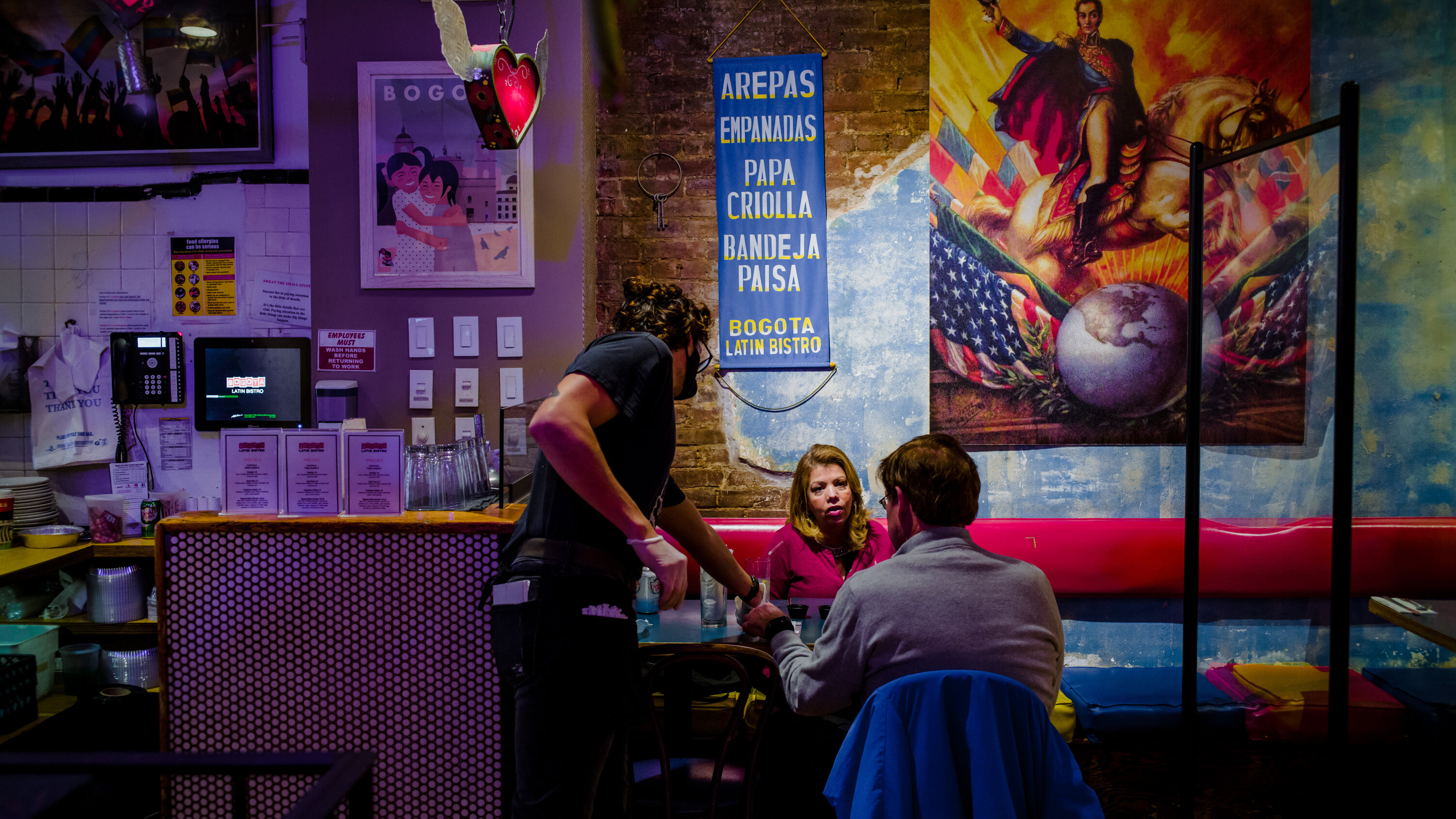
Gov. Andrew M. Cuomo of New York announced on Wednesday that officials were assessing whether indoor dining could soon return with limited capacity in New York City, after he barred it last month. He also eased coronavirus-related restrictions on nonessential businesses and restaurants in several areas across the state, including parts of the city.
The city’s restaurant industry, however, has been hit particularly hard during the pandemic, relegated mostly to outdoor dining for months, and Mr. Cuomo said officials were “looking at going back to the 25 percent” capacity limit that was set citywide when indoor dining briefly restarted in September.
He did not specify additional details, but said that a plan would come by the end of the week.
“I fully understand how difficult it is that they’re closed, not just for the restaurants, but all the people who are employed there,” Mr. Cuomo said. “On the flip side is how fast this virus can take off, but we’ll have a plan.”
It was a stark difference in tone from remarks made by Mayor Bill de Blasio of New York City on Tuesday, when he expressed concerns at a news conference over restarting indoor dining because of the high number of virus cases and the potential spread of new variants of the virus.
“I want to see indoor dining reopened when it’s safe,” Mr. de Blasio said on Tuesday. “So, when the numbers come down, and we’re confident that they’re staying down, that is a great time to do it. But obviously we’re not seeing that yet.”
On Wednesday, across New York City, 45 ZIP codes had a seven-day average positive test rate at or over 10 percent, according to city data. At the same time, some public health experts expressed concern that too much focus had been placed on vaccinations — as opposed to limiting the spread of the virus.
Restaurant owners across the state have also asked officials to push back their state-mandated 10 p.m. closing time to midnight. Mr. Cuomo said Wednesday that the state was “looking at” those requests, but would not be changing the hours at this time.
Months ago, Mr. Cuomo pledged he would largely lock down areas where positive test rates consistently topped 4 percent, closing indoor dining and curbing other high-risk activities. But few communities have faced new rules in recent weeks following changes to how areas of the state are divided into three color-coded zones, red, orange and yellow, that specify what measures apply in each place.
Outside of areas with zoned restrictions and New York City, indoor dining at restaurants has been permitted at 50 percent capacity statewide.
On Wednesday, Mr. Cuomo said that, statewide, all orange zone designations would be lifted, allowing activities like retail businesses operating at 50 percent capacity, in six places including Staten Island, Erie County and Westchester County. Brooklyn, Nassau County and Suffolk County were among 16 areas where Mr. Cuomo said the less-stringent yellow zone rules will be eliminated.
The only areas still under yellow zone restrictions are the Kew Gardens and Forest Hills areas of Queens, two parts of the Bronx, Washington Heights in Manhattan and Newburgh in Orange County, he added. Elsewhere, general precautions will still limit gyms to 33 percent capacity and residential gatherings to 10 people, among other broader safety measures.
“We’re not going to wait six to nine months to start to reopen the economy,” Mr. Cuomo said. “We’re not waiting because the future is what we make it.”
Key data of the day

How is it that Covid-19 cases and deaths in the U.S. aren’t moving in the same direction?
As President Biden’s new coronavirus team held its first public briefing on Wednesday, trends in the two closely watched metrics were painting a confusing picture. Average daily reports of new coronavirus cases in the U.S. have decreased 33 percent over the last two weeks, but reported deaths in the same period have remained near record highs.
One key common-sense factor goes a long way to clear the confusion. The people whose deaths are being reported now were probably infected — and then reported as new cases — weeks or even months ago. So their number mainly reflects the spread of the virus in November and December, when it was surging in most of the country.
“Deaths are lagged by at least three weeks” after case reports, Jennifer Nuzzo, an epidemiologist at the Johns Hopkins Bloomberg School of Public Health, said Wednesday.
There are other factors that could contribute to a disconnect between the case and death trends, like a shift in how many especially vulnerable people were becoming infected. But Dr. Nuzzo said she did not think that was the case now.
So if the overall case counts continue to decline, she said, “I think it’s more likely that we will see the deaths start to come down.”
Even with the recent new-case declines, the daily pandemic statistics in the U.S. remain troubling. On Tuesday, the country logged 151,616 new cases, and 4,205 deaths — close to the peak of 4,406 on Jan. 12. As of Tuesday, the seven-day average for new reported deaths stood at 3,341.
Overall, more than 25 million people have tested positive in the country, and more than 425,000 people have died, since the pandemic began.
The U.S. saw significant spikes in new reported cases after Thanksgiving and during the December holidays, most likely the result of increased travel and social gatherings. Now, experts like Dr. Nuzzo are concerned that cases will be driven up again by the new and more infectious variants of the virus that are circulating.
President Biden said this week that his administration would soon reach deals to purchase 200 million additional vaccine doses, which he said could allow 300 million Americans to be fully vaccinated by the end of the summer. But experts worry that the new variants could cause significant damage in the meantime.
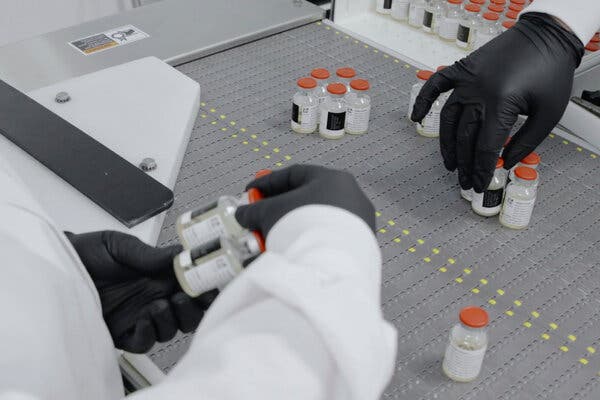
The monoclonal antibody treatment made by Eli Lilly is powerless against a variant of the coronavirus discovered in South Africa, according to a new study posted online on Tuesday.
In addition, one of two monoclonal antibodies in a cocktail treatment made by Regeneron also is significantly less effective against that variant, although the combination still works, researchers at Columbia University reported.
The findings underscore growing concerns that because of new mutations in its genetic material, this variant, called B.1.351, may be able to resist antibodies contained in these treatments and perhaps those created by the body following vaccination.
Dr. David Ho, an infectious disease expert at Columbia University, and his colleagues also tested the monoclonal antibody therapies against the coronavirus variant discovered in Britain. The therapies were reported to be just as effective as they had been against earlier versions of the virus.
But the variant in South Africa was a different story. Activity of the monoclonal antibody made by Eli Lilly, and one of the two made by Regeneron, was “completely or markedly abolished” when tested against the variant, Dr. Ho and his colleagues found.
A third variant identified in Brazil shares many mutations with B.1.351 and is expected to behave similarly, Dr. Ho said.
Over the past week, several teams of scientists have sounded the alarm that the Moderna and Pfizer-BioNTech vaccines seem to be slightly less potent against the variant in South Africa, although they still successfully neutralized the virus. The vaccines were just as effective against the variant identified in Britain as against previous forms of the virus.
Dr. Ho’s study confirmed those findings. It has not yet been peer-reviewed for publication, and was posted to the online server BioRxiv.
The new research does not have an immediate effect in the United States, because neither of those variants is known to be widespread in the country, Dr. Ho said. Just one infection with the variant from Brazil has been found, in Minnesota, and no cases of the variant from South Africa have been identified.
But the United States analyzes too few viral samples to be absolutely certain the variants are not already circulating here, Dr. Ho said.
In the future, new versions of the virus, including some that evade vaccines and monoclonal antibodies, will undoubtedly emerge, he added.
“We’ve got to expect more of this, because so many people are infected with this virus,” he said. “The virus has so many chances to mutate.”
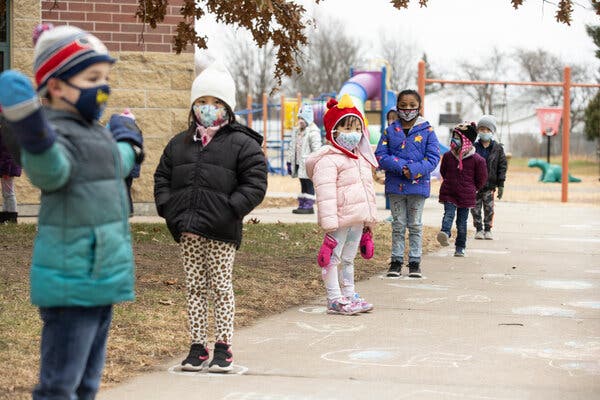
Rigorous scientific studies tracing the transmission of coronavirus in schools have been few and far between during the pandemic. But on Tuesday, the Centers of Disease Control and Prevention published a study of 17 rural schools in Wisconsin that found there was little in-school transmission, even though the virus was raging in the surrounding communities.
Experts and advocates have pointed to the study as evidence that it is possible to keep schools open safely even when community transmission is high, provided that mitigation measures — including strongly enforced requirements to wear masks and keeping students in stable groups — are used.
Among 5,530 students and staff members in Wood County, Wis., there were 191 coronavirus cases reported during the study, from Aug. 31 to Nov. 29. Only seven cases were attributed to in-school transmission, all among students. There was no surveillance testing, so some asymptomatic cases might have been missed. Overall, the rate of infection among students and staff was about one-third lower than in the county as a whole.
The study’s senior author, Dr. Tracy Beth Hoeg, a sports medicine physician with a doctorate in epidemiology, said the fact that no teachers or other staff members appeared to have been infected in school was “very, very reassuring.”
But others, including allies of teachers’ unions who oppose reopening before educators have been vaccinated, are already arguing that the study’s findings should not be widely applied.
The study setting was rural, and the students in the schools were mostly white. But it wasn’t obvious that the conditions in the schools were very different than those in urban districts. Students ate and attended classes indoors.
The students, who ranged from kindergartners to 12th graders, were in small, stable groupings of 11 to 20 students. Not all districts that have reopened created such small class settings. But in most urban districts that have reopened, only a fraction of students have returned in person, so class sizes are generally small — 9 to 12 students in New York City, for instance.
On CNN on Tuesday night, President Biden’s chief of staff, Ron Klain, said the study’s take-home message was that schools could open safely when they had an infusion of money to do so. Mr. Biden has proposed a $1.9 trillion package, which needs Congressional approval, that includes funding for reopening schools. The president is a close ally of teachers unions, which have been calling for major government investments in making schools safer.
The Wisconsin districts received a $150,000 grant to purchase cloth masks for all students. Mr. Klain suggested the grant had underwritten more safety measures. He also twice understated the size of the student settings in the schools, saying they were “classes of about 11 or 12,” and later, “classrooms of 12 on average.”
“What that study in Wisconsin from the C.D.C. showed,” Mr. Klain said, “was that 17 schools that got a sizable grant from a private foundation to put in the kinds of safety measures they needed — students in very small pods, classes of about 11 or 12, distanced, in a rural area — they could go to school safely.”
Asked by the CNN anchor, Erin Burnett, why teachers’ unions were ignoring the scientific evidence in opposing reopening, Mr. Klain disagreed.
“I think what you’re seeing is schools that haven’t made the investments to keep the students safe,” he said.
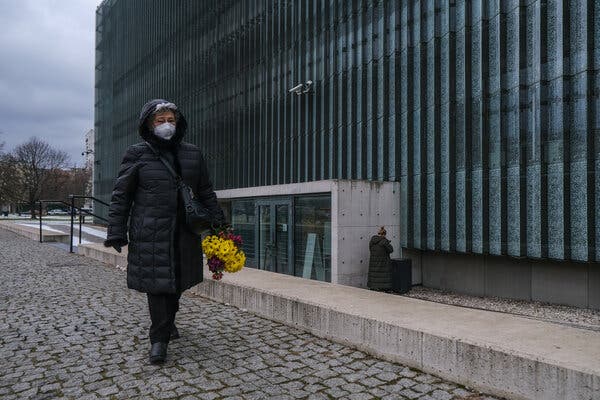
Hundreds of survivors of the Holocaust are set to be vaccinated this week in Austria and Slovakia as part of vaccine drives organized in observance of the 76th anniversary of the liberation of the Auschwitz death camp, a day known as International Holocaust Remembrance Day.
More than seven decades after one of the darkest periods in human history, the generation that endured the Nazi death camps is aging and especially vulnerable to the coronavirus. Jewish leaders have long pushed to prioritize their inoculations.
Some 400 people aged 85 and older, many of them Holocaust survivors, were being vaccinated in Vienna on Wednesday, according to the Jewish Community of Vienna, which helped organize the program in cooperation with the Austrian Ministry of Health.
About 12 doctors were administering vaccinations, according to Erika Jakubovits, executive director of the Jewish Community of Vienna, who helped organize the event.
“I think we owe it to our parents and grandparents to take care of these Holocaust survivors,” Ms. Jakubovits said on Wednesday, speaking by phone from a vaccine center.
A similar program was underway in Bratislava, Slovakia, according to The Associated Press.
“People are very happy,” Ms. Jakubovits said. “I think these are our most vulnerable members of society, and we have to treat them accordingly and to try to do everything for them.”
Moshe Kantor, president of the European Jewish Congress, this week called on European leaders to ensure that Holocaust survivors, who like other people of advanced age are extremely vulnerable to the virus, were given access to the vaccine. The organization estimates that approximately 20,000 Holocaust survivors are still living in Europe today.
“Throughout their lives, they have shown mighty strength of spirit, but in the current crisis, many have sadly died alone and in pain, or are now fighting for their lives, and many others are suffering from extreme isolation,” Dr. Kantor said, speaking during an International Holocaust Remembrance Day event held online this week.
“We have a duty to ensure that Holocaust survivors are able to live their last years in dignity and in the company of their loved ones.”
Global Roundup
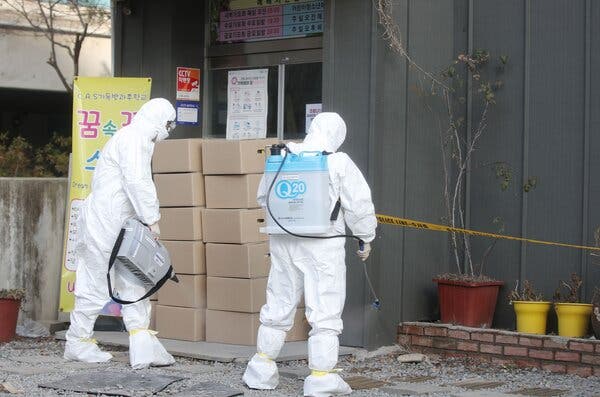
The South Korean health authorities said on Wednesday that they were conducting mandatory testing of dozens of religious schools, as the country struggled to tackle a wave of cases linked to a Christian missionary society.
South Korea reported 559 new cases on Wednesday, including 100 linked
in the southern city of Gwangju. That school is one of six operated by International Mission, a Christian missionary society, that have collectively reported more than 300 infections this month.
Yoon Tae-ho, a senior health official, told reporters on Wednesday that the health authorities were conducting mandatory or recommended testing of people at 32 of International Mission’s facilities. The group is based in the based in the central city of Daejeon and operates schools across the country.
International Mission apologized on Monday, saying in a statement that it thought the infections could have been influenza, not the coronavirus.
Religious groups in South Korea have driven several coronavirus outbreaks, including one linked to the Shincheonji Church of Jesus last winter in the southeastern city of Daegu. An antigovernment demonstration led by a Christian church in Seoul last summer also contributed to a sharp rise in cases, forcing the government to implement tighter social distancing restrictions.
In other news from around the world:
-
Madrid will suspend its vaccination program for two weeks because of a supply shortage, the authorities in Spain’s capital region said on Wednesday. The deputy head of Madrid’s regional government, Ignacio Aguado, told a news conference that priority needed to be given to administering second doses of the vaccine, particularly to frontline health care workers and residents of nursing homes. Mr. Aguado urged the central government of Spain to urgently demand extra supplies from the European Union.
Separately, the regional government of the northeastern region of Catalonia, also warned on Wednesday that a supply shortage was affecting its rollout program. “Tomorrow our fridges will be empty,” one regional health official, Josep Maria Argimon, said.
-
Hong Kong on Wednesday lifted a lockdown on a cluster of buildings after 11 hours, part of a new campaign to impose targeted restrictions on neighborhoods with coronavirus outbreaks. The lockdown in the densely populated, working-class Yau Ma Tei neighborhood is the second that the government has imposed during the pandemic. The first came into effect on Saturday amid concerns that the virus was spreading rapidly in tenement apartments. It was lifted about 48 hours later, after officials found 13 new infections among the roughly 7,000 residents they had tested. The Chinese territory’s leader, Carrie Lam, called the operation a success and promised “ambush-style” lockdowns in the future. Officials said on Wednesday that they had discovered one infection during the second lockdown, out of about 300 residents tested.
-
South Africa has given emergency approval to the Oxford-AstraZeneca vaccine and is reviewing applications by rival manufacturers, the country’s medicines regulator said on Wednesday. Helen Rees, the chairwoman of the regulator, the South African Health Products board, announced the decision during a news briefing and said that the minister of health would share more details on the country’s next steps later in the day.
-
President Joko Widodo of Indonesia received on Wednesday his second shot of a vaccine made by the Chinese company Sinovac, a day after the country of 270 million people surpassed one million reported infections. Mr. Joko said that 250,000 health workers in Indonesia had already received their first shot. About 50,000 people are now being vaccinated each day, he said, adding that he hoped to raise that number to one million.
-
Nepal on Wednesday began the first phase of a nationwide vaccination campaign for health care workers and other frontline personnel, including cleaners, security guards, and ambulance and hearse drivers. Nepal is one of several countries in South and Southeast Asia to have received donated doses from India of Covishield, a vaccine developed by AstraZeneca and Oxford University and manufactured by the Serum Institute of India. But the Covishield shipment to Nepal was for one million doses, and the government has not yet explained how it plans to execute its plan of vaccinating 72 percent of its 30 million people.

New York City’s school enrollment fell sharply this year, the latest sign that students across the country have left the public school system temporarily or even perhaps permanently during the coronavirus pandemic.
Enrollment in the nation’s largest public school system, with nearly 1 million students, fell by about 4 percent, or roughly 43,000 students, from the previous year, according to data released by the city on Wednesday. Most of the enrollment drop was concentrated in early grades, especially prekindergarten classes for 3- and-4-year-olds.
The decline reflects how some parents are delaying enrollment because of the limitations of remote learning, which are particularly acute for young children, while others are opting for home-schooling, either short-term or indefinitely.
The decline in enrollment is sobering news for the school district, which has partially reopened its classrooms while many other large urban school systems have struggled to do so. The new numbers could affect state aid to the city’s public school system, though it is not yet entirely clear how.
Still, enrollment in New York City has been declining at lower rates for years, as many students have left traditional district schools for charter schools, which now enroll over 100,000 children.
Public school enrollment has also declined in states across the country in recent months, including Massachusetts, Montana and Missouri.
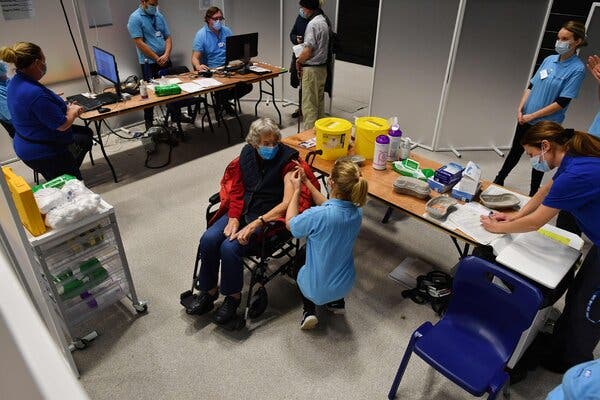
For months, wealthy countries have been clearing the world’s shelves of coronavirus vaccines, leaving poorer nations with little hope of exiting the pandemic in 2021. But a fresh skirmish this week has pitted the rich against the rich — Britain versus the European Union — in the scramble for vials, opening an unabashedly nationalist competition that could poison relations and set back collective efforts to end the pandemic.
The European Union, stung by its slow progress on vaccinations, threatened this week to tighten rules on the shipment of Belgian-made shots to Britain.
British lawmakers, in turn, have accused their European counterparts of a blackmail campaign that could embitter relations for a generation.
And poorer countries, already at the back of the line for vaccines, could face even longer waits if the intense squabbling among rich countries drives up prices for everyone else.
At the core of the problem are production delays at separate factories in Belgium that make the Pfizer-BioNTech vaccine and the one developed by AstraZeneca and the University of Oxford. With a new and more contagious coronavirus variant fueling a surge of cases in several European countries, those delays have undermined efforts to get shots into millions of people’s arms, ratcheting up the global competition.
But the manufacturing of vaccines is only part of the problem. Public health experts say the entire global system of buying doses, pitting one country against another with little regard for equity, is unfit to the task of ending a pandemic that respects no borders.
For the European Union, problems with its vaccination campaigns have reinforced criticism of the bloc’s bureaucracy. Unable to speed up vaccine makers, the bloc’s leaders have instead resorted to threats about the export process, a sign of the severe pressure facing them as the European Union falls far behind Britain and the United States, which made advanced purchases of vaccines earlier, and have been quicker to authorize the shots and get people inoculated.
Britain has given vaccines to 10 percent of its people so far, compared to about 2 percent in the European Union. Britain was the first country to authorize a fully tested coronavirus vaccine, and the government of Prime Minister Boris Johnson has trumpeted its successes.
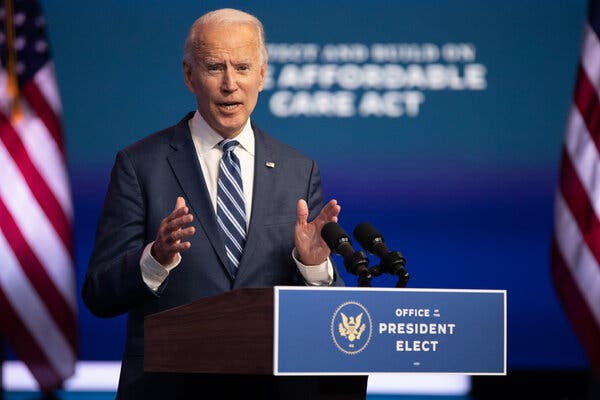
The Biden administration plans to reopen enrollment in many of the Affordable Care Act marketplaces, both to help those who may have lost health insurance during the pandemic and to offer coverage to those who did not have any and now want it. The move will be announced on Thursday as part of an executive order describing administration policies on shoring up health insurance coverage, according to three people familiar with the details.
The so-called special enrollment period is intended to help people who have lost coverage in the past year, but it will be open to those who want health insurance for any reason, in the 36 states that use Healthcare.gov. The decision was reported earlier by The Washington Post.
Typically, Americans without a special circumstance can buy Obamacare insurance only during a six-week period in the fall, a restriction meant to encourage people to hold coverage even when they are healthy. The sign-up period for this year’s coverage ended in mid-December, with enrollments only slightly higher than they were last year. But the Trump administration did little to advertise it. The Biden administration plans to have a large marketing campaign to announce the new opportunity and encourage people to enroll in health plans, two of the people said.
The insurance industry, which usually supports tight limits on insurance enrollments, is backing the extra enrollment period now. Around 15 million Americans are uninsured and eligible for marketplace coverage, according to a recent analysis from the Kaiser Family Foundation. Most would qualify for some form of financial assistance if they bought such coverage — and about four million could sign up for a high-deductible plan that would cost them nothing in premiums.
“For the four million people who could be getting free coverage who are instead uninsured — that, to me, is screaming out for outreach,” said Cynthia Cox, a vice president at the foundation and a co-author of the analysis.
It remains unclear how many people lost health insurance last year because of the pandemic, but most working-age Americans receive coverage through their employers, and millions have lost jobs.
Enrollment in Medicaid, the public health insurance program for the poor and disabled, has grown substantially during the pandemic. And consumer advocates say there are also many Americans who were uninsured before but might want coverage now because of the public health crisis. Several states that run their own marketplaces established special enrollment periods last year and saw increased sign-ups.
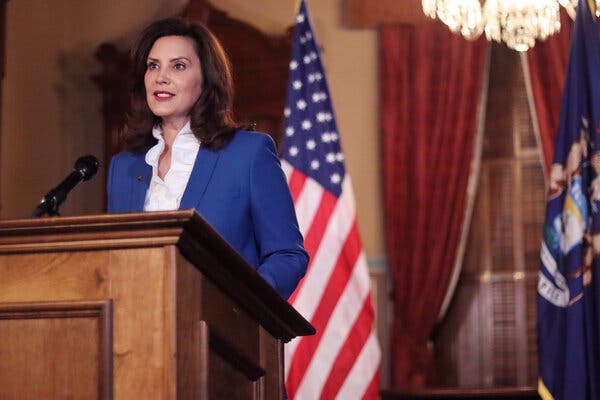
Gov. Gretchen Whitmer of Michigan opened her annual State of the State speech on Wednesday by pleading with lawmakers to find common ground in fighting the staggering effects of the coronavirus pandemic in the state.
“Based on the political environment this past year, you might think Republicans and Democrats in Lansing can’t find common ground on much of anything,” said Ms. Whitmer, a Democrat. She noted times when there had been bipartisan action in the Capitol. “Let’s tap into that same energy and end the pandemic, revitalize our economy and get our kids back in school.”
But Republicans were having none of it.
Hours before Ms. Whitmer gave her speech, Republicans in the State Senate refused to approve 13 appointments she had proposed for slots in state government, such as the leader of the Children’s Ombudsman Office, the Civil Rights Commission and members of agriculture boards.
Republicans said they had rejected the appointments because they felt Ms. Whitmer was not including them enough in decision-making surrounding restrictions placed on businesses to stop the spread of Covid-19.
“She has continued to circumvent the Legislature,” said State Sen. Aric Nesbitt, a Republican from Lawton. “I understand it’s not easy to compromise and try to work with 148 members of this Legislature. We have to use every tool available to compromise, and one of those tools is to not support her appointments.”
Republicans in the State House of Representatives followed suit, offering a Covid relief plan that would withhold $2.1 billion in federal funding meant for schools to cope with the pandemic until Ms. Whitmer relinquished her authority to shut down in-person learning and sports during a health crisis. That power would shift to local health departments under the Republican plan.
The public and pointed rejections of the governor’s appointments and authority came as the 2022 election cycle began ramping up. Ms. Whitmer is up for re-election in 2022, and no top-tier Republican has come forward to challenge her.
Forced to speak remotely instead of in front of both chambers of the Legislature because of pandemic protocols, Ms. Whitmer offered plans to fix roads, provide extra hazard pay to teachers and allocate state resources to help residents who have lost their jobs during the pandemic find employment.
But it was the coronavirus, which has infected more than 600,000 state residents and killed more than 15,000 since it was first reported in Michigan in March, that dominated her address.
She said she planned to start a statewide tour to talk with Michiganders from all walks of life, Republicans and Democrats alike, to try and find common ground as the state emerges from the pandemic. The tour is designed “to focus on what unites us, improve how we talk to each other,” she said. “My mission is to find common ground so we can emerge from this crisis stronger than ever.”








